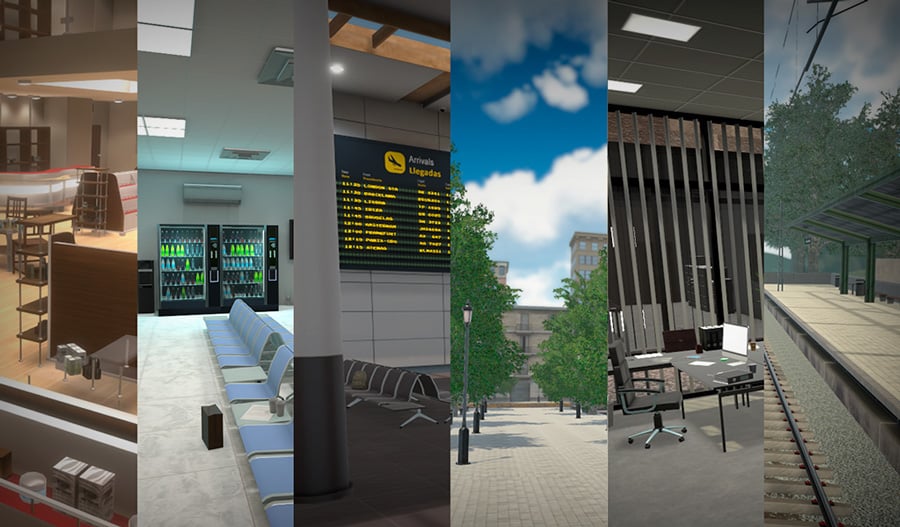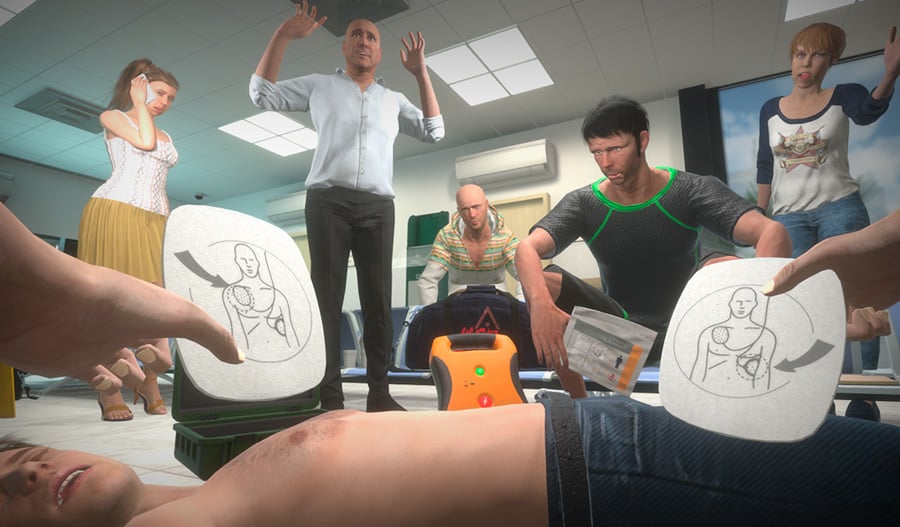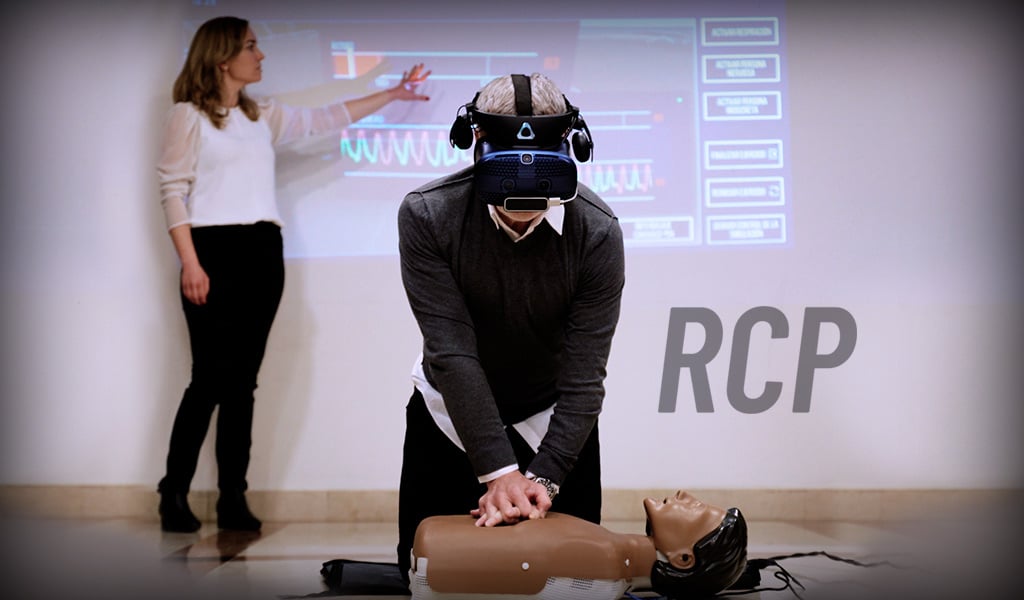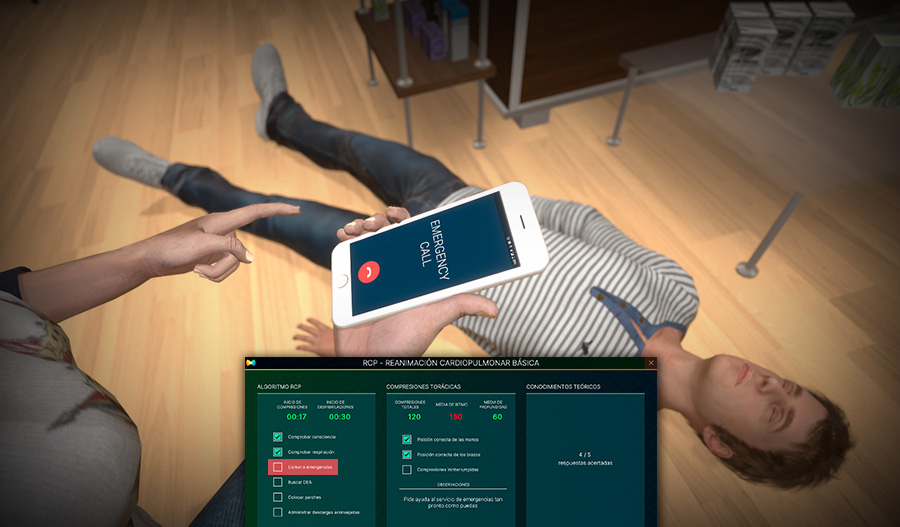CPR (cardiopulmonary resuscitation) courses are a necessary tool to protect hundreds of lives. In a previous article we discussed how there are certain barriers that prevent CPR training from becoming widespread among the general population. However, the arrival of a specific type of technology with training potential may well help to overcome these barriers: virtual reality.
Why is it important to make CPR training widely available?
A cardiorespiratory arrest can occur at any time and in any place. There will not always be a doctor nearby to perform CPR on our loved ones, which is why it is important that we all know how to perform the manoeuvre.
The Spanish Council of Cardiopulmonary Resuscitation (CERCP) states that 80% of heart attacks occur at home. This is why it is so important to make CPR courses widely available to the general public.
Cardiopulmonary resuscitation has evolved throughout history. The process leading to the CPR courses we know today has developed over several centuries. From bizarre methods such as blowing smoke into the victim's rectum to milestones such as discovering chest compressions. Indeed, CPR has come a long way.
When it comes to CPR mass training, cinema and television have the ability to take advantage of their great potential for dissemination. There have been numerous scenes of cardiopulmonary resuscitation in these types of media, but in many cases, they are depicted with mistakes that in reality would be fatal.
As we said, the emergence of new technologies such as virtual reality is a much needed boost when it comes to making CPR courses more widespread.
Virtual reality to overcome barriers that prevent the massification of CPR courses
Virtual reality simulations recreate realistic scenarios and situations. By putting on a VR headset, the user is immersed in a first-person experience in a virtual environment. This has great potential in training courses such as CPR, as the student practises the manoeuvre in a realistic simulation.
As for the obstacles that make it difficult to make CPR courses widespread among the population, this technology helps to overcome them.
Tackling lack of motivation with a playful and dynamic tool
The lack of motivation to learn the CPR manoeuvre is one of the barriers to overcome. Virtual reality allows the manoeuvre to be taught in a dynamic way, with different variables and scenarios such as an airport or a shopping centre... This helps to make the experience fun for the students and gets them involved in the CPR courses.

Being an innovative tool with similar mechanics to those of some video games, it also has a great educational impact on generations of digital natives. Moreover, an increase in motivation is linked to better knowledge retention in both the medium term and the long term.
In addition, there are other methods for learners to retain information from CPR courses in an entertaining way. One such method is to use music to teach the rhythm of chest compressions, with songs such as 'Stayin' alive'.
Bringing more realism to CPR courses
Lack of realism is one of the problems with CPR training. Although students practice with a bust, they do not get to experience the actual distress of a real emergency. This can lead to a mental block in the event of a cardiorespiratory arrest, which can be fatal for the victim.
Virtual reality helps to work with these possible scenarios in CPR courses. The learner experiences a realistic situation, having to rescue a victim in everyday settings. The technology allows the inclusion of other elements that increase stress, such as virtual characters that disturb the trainee.

Realism and stress in CPR training are essential to avoid subsequent failure. In a previous article, we described what it is like to keep a heart beating with a virtual reality CPR simulation.
Confidence in the skills to perform the manoeuvre is reinforced.
Speaking of mental block, one of the biggest obstacles to performing CPR is a lack of confidence. For fear of doing more harm or not performing the manoeuvre correctly, we may fail to rescue the victim. This is a fatal mistake, as even performing poor CPR is better than not performing CPR at all.
A person who is lying dead on the ground, not breathing and with no heartbeat is dead, and his or her chances of survival are decreasing every second. Therefore, there should be no hesitation and no time should be wasted in performing CPR.
Virtual reality simulations make it possible to practise CPR in different environments and circumstances: whether or not there is a defibrillator, agonal respiration of the victim... This practice in realistic environments and situations favours the student's muscle memory and helps to strengthen their confidence later on.
The cost and complexity of running CPR courses is reduced.
The Ludus CPR simulation has both a guided mode and a free mode. This means that, when organising CPR courses, they can be run autonomously. This is a very useful option for refresher training, for example. The trainees or employees go through the simulation independently and refresh their knowledge without having to be organised in a group.
This possibility not only makes it less complex to organise CPR training but also helps to reduce costs. As there is no need to stop a group of people from working for the training, the centre's business operations do not come to a standstill. Savings are then made both in training hours and in costs due to process stoppages.
At the end of the exercise, a score is displayed based on parameters such as reaction time, completed steps, well-answered questions... This evaluative component provides feedback on the trainees' performance and ensures that they have mastered the manoeuvre.

In addition, the Ludus simulation offers a real-time evaluation of the rhythm and depth of compressions. This is another aid to train the student's muscle memory, as he or she visually checks if they are adjusting to the correct parameters.
Are you interested in implementing Ludus virtual reality in your CPR training, or would you like more information about our simulations? Leave us your details in this link and we will contact you.








